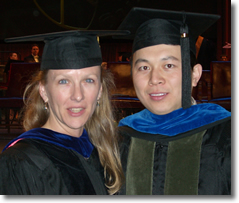Congratulations 2005-2006 Graduates

Dr. Lianbo Yu performed his Ph.D. research in the area of statistical bioinformatics under the direction of Professor Rebecca W. Doerge. The title of his thesis was: "Statistical Issues in Protein Microarray Analysis."
Lianbo's research is focused on protein microarrays which have emerged as a technology that is leading us to a new era of proteomics. Although protein microarray experiments allow the simultaneous study of hundreds or thousands of proteins in a high-throughput fashion, they also have a variety of experimental and statistical issues that need to be addressed. The purpose of Lianbo's work is to develop statistical methods to address the design and analysis issues, e.g., the selection of functionally consistent proteins and the identification of differentially expressed proteins. Since protein structures are usually not as stable as DNA molecules, the selection of functionally consistent proteins is an essential preliminary step in the fabrication of protein microarrays. Toward this end Lianbo proposed a novel semi-nonparametric mixture model to classify functionally consistent proteins and functionally inconsistent proteins. The expression of functionally consistent proteins is then assessed under experimental conditions using microarray technology. Identifying differentially expressed proteins across different experimental conditions is the motivation for many protein microarray experiments. The many statistical approaches for identifying differentially expressed proteins range from parametric to nonparametric. Parametric methods often require strong distributional assumptions from the data, and while nonparametric methods are robust they may not be powerful. To balance the tradeoff between parametric and nonparametric approaches, Lianbo proposed a novel semi-nonparametric method for detecting differentially expressed proteins. Simulation results demonstrate the power of the semi-nonparametric approach as significantly higher than the nonparametric empirical Bayes approach while requiring minimal distributional assumptions.